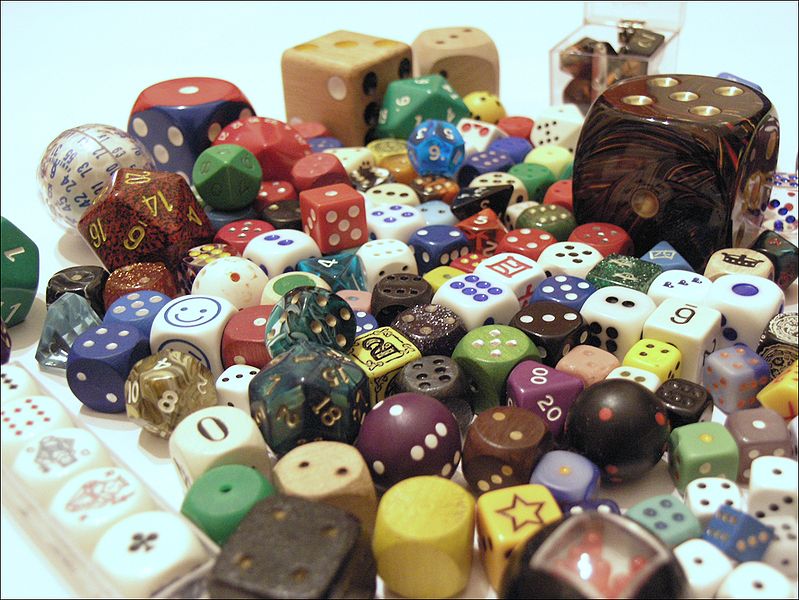Intro: Keep it interesting!
RPGs evolve. New games don’t just invent snazzy new mechanics; they poke deep into questions of what game-table play is about.
MERC stems from author Ben Finney’s interest in the innovations of recent games, and ways to strengthen those concepts in the now-classic RPG GURPS. Broadly speaking, MERC is a set of guidelines for placing story first and making the most of gamers’ time at the table. More narrowly, it homes in on a key question at the heart of all RPGs: When should the dice be used at all, and toward what end?
From the GURPS perspective, that often equates to “When should we make success checks?” The general answer to that is clear to gamers with minimal experience: “Roll where the outcome is meaningful and interesting. Roll to have the PCs survive a dangerous car chase, not to eat breakfast without spilling the orange juice.” We all know that, and MERC doesn’t contradict this truism.
But that said, a beginning GM won’t hurt for a more contemplative look at when to roll dice; even an experienced GM might freshen his games through a reexamination. More importantly, what MERC suggests actually may represent a new take on play for some gamers: A shift from many games’ focus on resolving tasks, to a focus on resolving players’ intent (with some crunchy GURPS-flavored dice-rolling guidelines to aid in that).
“What? I don’t have to write the whole adventure script by myself?”
MERC is almost as new to me as it is to you, Reader, so I need to try applying it at the game table. At present, it does appear to offer me food for GM thought. I see a call to de-emphasize resolution of tasks put in place by the GM as challenges to the characters, instead asking what the player wants to happen in the scene, and how the player will have the character act toward that goal. I see advice to ensure that every dice roll is there for a good, story-driving reason – as Ben puts it separately, “to ensure that every roll, before it’s made, has personal investment from at least two people at the table”. I see a suggestion for the GM to hand over some game control to the players, more so than classic RPG rules tend to prescribe.
Sharing the storytelling reins isn’t a new concept to me – I’ve certainly seen it spelled out in many forms in recent RPGs – but I know that I’ve been guilty of not taking that advice. I can recall games in which I’ve clung to old-school GMing, keeping players focused too tightly on their characters alone, because everything else is my responsibility as GM. That doesn’t mean we don’t have fun, but the mindset can lead to problems like railroading and an overworked GM. I think it’ll help my GMing to have insights from several modern games condensed into one set of guidelines tailored to my favored RPG, per Ben’s efforts.
The MERC guidelines begin below. Does this appear a useful framework for keeping conflict resolution interesting in any game? Or maybe only for some game styles? Or do you see potential problems lurking within?
MERC guidelines
Intent-based task resolution for engaging play
- Copyright: © 2008 Ben Finney <ben+gurps@benfinney.id.au>
- License: Permission is granted to modify and/or redistribute this work in any form, provided this copyright notice and license grant are preserved in all copies.
- Last-Updated: 2008-12-10 11:22
Say yes or roll the dice
Conflict is the only reason to roll the dice
If there’s no interesting conflict, say yes and keep moving
Whenever conflict occurs, use conflict resolution to determine the result
Authority
The GM is responsible for game world and NPCs
Players are each responsible for their characters
Everyone must offer contributions on areas outside their own responsibility
Collaborative storytelling
Nothing will happen unless you make it happen
Get all players involved in making scenes interesting
Character secrets are kept from other characters, never from other players
State intent
Acting player describes what success will look like
Set the stakes
Opposition (another player, or GM) describes what acting player’s failure will look like
Whiff is not an option
Something interesting happens to change or complicate active player’s intended result
Determine the task
Intent determines which ability will be tested on each side of the conflict
GM determines task difficulty modifiers
Acting player can:
Raise the stakes to change the nature of the conflict
Concede the opponent’s intent without conflict
Walk away, ending their involvement in the scene
Accept the conflict and roll the dice
Result must progress the story
Three possible outcomes (per Mouse Guard RPG): success, success-with-condition, failure-with-twist
Success ⇒ achieve intent as described
Nothing can change the fact that intent was successful as described by player
Margin of success can grant more than was described, but never less
Failure ⇒ opposition’s description occurs
Margin of failure can determine whether some degree of intent is achieved, but never complete
Can succeed at task while failing intent
Tie ⇒ deadlock
Neither side gets their intent
“Let it ride” (below) applies
- If both sides agree, can be escalated to different stakes
Let it ride
Repeating rolls is boring, and doesn’t make sense if “whiff” results are eliminated
- This idea is incompatible with ‘Repeated Attempts’, p. B348
Each ability only tested once per intent, task, and situation
Result, and margin, remains unchanged until situation significantly changes
- Any change in result can only come from a significantly different intent, task, or situation
Applies only to intents achieved via a success roll or contest, not to extended conflict resolution
Supporting actions
Linked tests
- As part of intent, may declare linking current test to a specific subsequent test
- Must narrate how the two tasks are related
- Narration subject to group consensus
- Modify subsequent test based on result of this one
- critical success: +2
- success: +1
- failure: –2
- critical failure: –4
- Limit 1 linked test each
- Encourage multiple linked tests in series to describe a progression of events
Help
- Other character can use their skill to assist your test
- Not a separate intent or test, merely a bonus from direct assistance
- Must narrate how other character’s skill use assists this test
- Narration subject to group consensus
- Modify test based on skill level of assisting skill
- skill level ≤9: no bonus
- skill level 10–15: +1
- skill level ≥16: +2
- Limit 1 helping skill per character per test
Related expertise
- Use a knowledge-only skill to help with current test
- Area Knowledge, Connoisseur, Current Affairs, Expert Skill, or Hobby Skill
- Must narrate how the knowledge assists this test
- Narration subject to group consensus
- Modify test based on skill level of assisting skill (as for “help”, above)
- Limit 1 related expertise per test
-end-




10 Comments
Adult Role Playing
Letting the players take control is a must for any fully detailed world.
As for limiting rolls, this doesn’t seem to address the source of much of the problem when dealing with gaming systems and rolling dice – lots of powers and options to consider, multiplied by lots of combatants. Consider 7th Sea and its brute squads, for example – groups are treated as a single, functional character. It works quite well.
Another alternative, especially in high-powered games, is to consider mobs of hostile, individually ineffectual characters to simply be a hostile environment.
tbone
True, limiting dice rolls is just one small simplification, whereas games often have many time-consuming complexities. Combining fewer dice rolls with other combat simplifications like you mention, though, can make for a nice streamlined game.
Adult Role Playing
Letting the players make their own choices is necessary. Assuming you can DM on the fly rather than a bunch of pre-planning. Limiting rolls is a good first step for many options buuuuuuuuut, large numbers of characters are generally a problem in any combat system. I’m with the other guy, use them as a hostile environment or pool them into a single ‘swarm character’ with high-powered stats to match.
tbone
I remember some old RPG sessions that started out using regular rules to let super-powerful PCs wade into armies of foes, and start taking them down… and more the next round… and the next… again and again… It got so repetitive that the GM just started hand-waving the actual rules, and decreeing that the PCs took down X enemies per round. And after some time of that, finally, it just devolved into “Okay, you wipe out the rest of them.” Done.
It might sound a wee scandalous to by-the-rules GMs, but it was good for keeping the story going (in a not-too-serious cinematic game), and good from a fictional story-telling point of view, too. That’s how a good book or movie would handle such a mass fight as well: Start with some detailed scenes highlighting the actions and capabilities of all involved, and as soon as that starts dragging, condense the rest and get on with the conclusion!
Trygon
I never went for overly-open systems. Some people thrive on it, I’m sure, but it never worked for me.
Trygon
Open ended systems never really did it for me. I prefer more restrictive rules. Taste, I guess?
tbone
I tend to like simulationist – I guess you could call that “restrictive” – rules for combat and other physical feats. But as guidelines for the bigger picture, for keeping the broad story moving and keeping players engaged, I think MERC is a good set of guidelines.
tbone
This is a reply to Radoslav’s comment in another thread; I’m moving the discussion here where it fits better.
Although I haven’t played Burning Wheel, I’ve talked about it with gamers, and am familiar with the “boon” type of reward for good roleplaying or other actions that make the game more fun. I call them “hero points” in the generic, non-game specific sense. As I’ve seen in various game systems, they generally let players modify task success (i.e., take bonuses on a roll), or in some games, even change determined results or otherwise dictate game happenings.
I think hero points are a great mechanic, and definitely plan to use them more in the future. In particular, as Radoslav notes, they’re arguably a more fun reward for good roleplaying than are character points; they offer something that can be used here and now to make fun things happen in the game, rather than something that’ll be used later in a post-game bit of character updating. More and more, I like the idea of predictable, steady character point advances that are equal for all players, mixed with much more varied and freely-awarded hero point awards that may differ greatly by player. It’s fun to give out awards, and points that are made to be quickly consumed don’t carry the downside of character inflation! (Likewise, it avoids the hard feelings that can happen among players when the permanent stuff – character points – is distributed unevenly.)
Somewhere I have a good list, cobbled from many sources, of possible ways a game can allow hero points to be used. Will have to find that and post.
VIVIT
Oh boy, it’s this. I think this may be the first time I’ve ever read this. It’s even goofier than I imagined.
Let me get my most value-laden value judgment out of the way first: roleplaying is not storytelling. Roleplaying is assuming a imaginary persona in some imaginary scenario and having an experience. That experience doesn’t need to follow the rules of narrative convention to be interesting or memorable. In fact, part of the beauty of it all is that even when you don’t set out to tell a story, you end up with stories to tell. And these stories are all the more compelling if you let them unfold naturally rather than prematurely forcing your sense of dramatic correctness onto it.
Collaborative storytelling exercises like round robins and improvisational theater can be interesting, but they aren’t roleplaying games. It’s neat that RPGs have borrowed ideas from those hobbies, but when you follow this trend to its logical extreme you end up with something that’s less like an RPG and more like improv with dice. You don’t need dice to tell a story, so it’s only natural for the theater geeks to wonder what they add to the game. The answers they’ve come up with might work for them, but I kind of resent the way that those ideas have taken hold in the broader RPG community, particularly in such a dogmatically prescriptive form.
Maybe this wasn’t what Finney meant by what he wrote; maybe this reading is informed by the way that I’ve seen others implement this type of advice in the years since, but what I’m reading is this:
– The only reason to roll the dice is to resolve to roll the dice is to resolve dramatic tension. Any other use of the dice is a waste of time.
– All rolls must “move the story forward” in some overt and obvious way. Simple failure is never interesting.
– It is more important for results to be interesting (by this particular extremely narrow definition) than it for them to make sense or be consistent.
I don’t want to make a strawman of Finney here, but I have seen these ideas unironically taken to that kind of extreme.
tbone
In a nutshell, I see the MERC article as showing how to adapt GURPS to another style of gaming – not yet another genre or setting, but the collective narrative style of play you speak of.
Which isn’t to say the system doesn’t already have a foot in that door. There have long been switches for more cinematic play, suggestions to “roll and shout”, player control via impulse buys, traits like Serendipity that invite players to suggest gameworld events, etc. But in GURPS, these really don’t let players stray far outside the “you get to control your PC” corral.
MERC is prescriptive, but I read it as “if you want that more collaborative storytelling/improv style, here are guidelines”, not “you should adopt a collaborative storytelling/improv style”. I like that Ben Finney has written that up for any GMs interested in trying out a new style, or anyone outside the system saying “sure, GURPS handles all kinds of genres, but only in a simulationist style, with limited room for players to do more than control PCs.” It’s cool to see a counter-argument of “No, GURPS can do all-hands collaborative storytelling, too. Here are guidelines.”
On a side point: I have no beef with placing such collaborative storytelling games under the “roleplaying” label. Maybe in a given game, the players are practically LARPing, barely touching dice, replacing nearly all mechanics with a Talking Pillow and overly dramatized improv theater. But as long as the players are acting the roles of characters, that’s roleplaying in my book.
But as for whether I like such games: I think we share a lack of interest in switching to those. As you note, there seem to be more and more games taking an “improv with dice” approach toward storytelling, with broad collaborative input by players. I see so many new (especially indie/solo) games that boast “rules light” and “simple” (both fine goals in principle!), that have fascinating and terribly creative settings/backgrounds, and that look fantastic (well, sometimes), all of which is great… but when it comes to the “resolving things” part of the game, there’s not much there there. There’s always some sort of mechanic, sure, usually involving dice, but… I’m blanking on a good comparison here, but with some games, the mechanics have a feeling of flipping Tarot cards. You’re doing a thing, yes, but from there it’s just “Interpret this in the way that works for you.”
All of which doubtless is fun with the right people, so if the group is enjoying their game, with its barely-there “mechanics” and all, they’re doing things right. But me, I still like games that offer more concrete resolution, covering lots of things. With a game like that, when you want crunchy, hard resolution, it’s there (I always view this as “the game designer has actually done the hard work”). When you’re good with a soft “hey, who’s got a cool idea for what happens next?”, you just ignore the crunchy mechanics. A game like that offers the best of both worlds, to me.
So I’m not in the target market for full conversion to MERC-like play, but I have benefitted from ideas in MERC (and similar guidelines). I took it as advice to be a little looser in letting players suggest directions, to keep an eye out for situations where “Can succeed at task while failing intent” makes sense as an outcome, and to implement more “success-with-condition, failure-with-twist” outcomes.
An example of the latter: I try to treat success by 0 as a mixed result, not success, whenever I can imagine some meaningful mixed result (like a glancing blow instead of a solid hit). In particular, it’s a good opportunity to introduce some result that mechanically wouldn’t come up otherwise. For example, by the rules, a PC slipping off a high perch either catches the ledge and is left hanging, or misses the ledge and falls. Success by 0 is a good opportunity to say “OK, you catch the ledge, but drop the treasure sack”, a nicely cinematic outcome.
Some other bits I’ve decided aren’t for me. Like “Whiff is not an option”. This is excellent advice for a game that’s meant to play out like smoothly-crafted fiction, where storytelling dictates that things don’t happen unless they’re exciting and make a difference. But here I pull my simulationist cap down tight and say “Nope, I don’t need my RPG reality to fully follow cinematic reality; attempts definitely can whiff. Improve your abilities, or more cleverly tilt the odds, if you don’t want to whiff.”
In short (as if…), for me this article has been a nice source of pick-and-choose ideas and advice, not a wholesale gamechanger. But if anyone wants to play GURPS with all the dramatic conventions of newer games, I think it’s a nice guide.